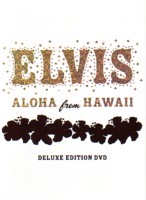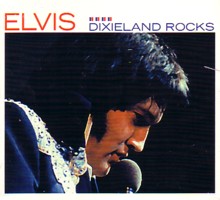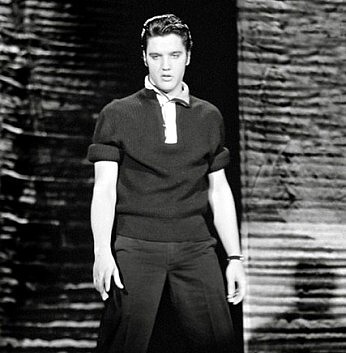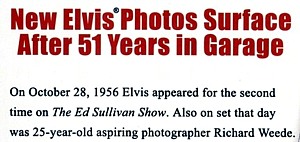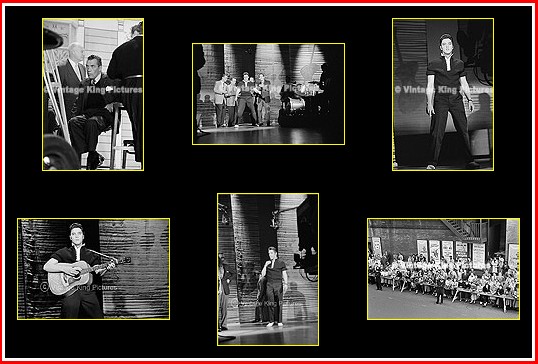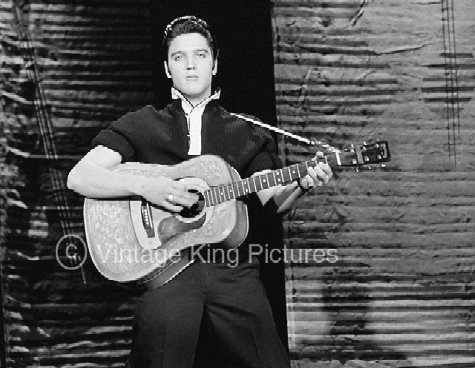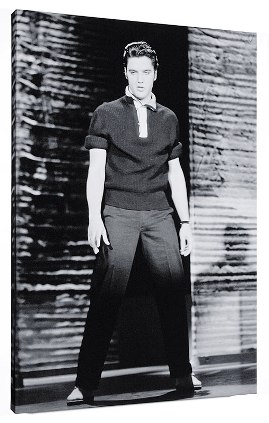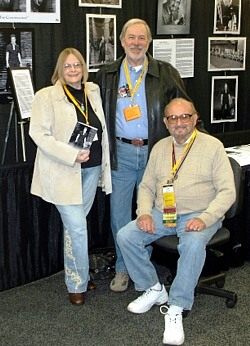 |
 |

EIN: Thanks so much for agreeing to this interview I know you are a busy man. Every Elvis fan would have to be very envious that you were there in 1956 to witness Elvis in rehearsal for this historic show with Ed Sullivan. Richard Weede: Not really. I was going to New York Institute of Photography and doing head shots and composites for singers, dancers, actors, getting some excellent experience. (Click here for more info on the New York Institute of Photography) EIN: Did you ask to photograph the rehearsal with any particular performer in mind, or were you just interested in being there for a look at an Ed Sullivan show? RW: As you know, my Father was on Broadway at the time in the lead of the Frank Loesser musical "The Most Happy Fella". The Sullivan show booked about three scenes of "Fella" for the broadcast of Sunday, October 28, 1956. Happy Fella was one of the two or three "really big shows" (can you say that with the Ed Sullivan inflection?) on B’way at that time, so this was to be pretty much a Robert Weede and "Most Happy Fella" broadcast. I accompanied my Dad to the theatre for rehearsals early in the day. I had been documenting the show since its early rehearsals in New York and throughout it’s run, so it was natural for me to show up with my camera hanging around my neck. In those days, if you showed up with a professional looking camera and a professional attitude, you could get into most anyplace. By some quirk of fate, there was also this young man named Elvis to appear on the same show. Naturally I photographed him along with the rest of the show. EIN: With Elvis’ meteoric rise there must have been a pile of news photographers wanting to be there at Elvis’ performances. How did you manage to get invited to be there for this TV rehearsal over the others? RW: Well, I wasn’t really invited. After we got there, my Father may have said something to the director in my behalf, but I’m not really sure about that. I just wasn’t hassled, and I was theatre-wise enough to know where to be and where not to be. I actually cannot recollect any other photographers being there, although I know there was at least one other since I have seen another photograph taken that day and in one of my photographs there is a shadow of another photographer using a waist-level camera, maybe a Rollie. I would assume that the director would not normally allow photographers on the set. You’ve seen pictures of twenty photographers stumbling over each other as they jockey for the best angle. EIN: Did you have to get permission from CBS or/and Colonel Tom Parker? RW: As I said, I really didn’t get any official "permission" and I really don’t think Col. Parker was there. EIN: Had you seen Elvis performing in his previous TV appearances? Did you realise just what a huge Pop Star he would become? RW: Can’t say that I had ever "seen" Elvis prior to this time, but I had certainly heard him, and I am guessing that I had hopes he would NOT become a big star. EIN: Were you apprehensive being at the rehearsals, did the other performers mind that you were there candidly photographing them? RW: I’m sure there was some bit of apprehension not being sure of being accepted by Sullivan and the show’s director, but there was certainly no problem with the other performers. Most of them were used to me being in the wings or in the dressing areas. EIN: Your father was the famous opera baritone and theatre star Robert Weede who performed with stars like Maria Callas. What music were you brought up listening to, did this mean that you weren’t a rock’n’roll fan? RW: I was brought up listening mainly to operatic singers. My Dad did a lot of teaching and somehow we usually had a student living with us. My earliest such memory of this was when I was in the second grade, a young baritone from Baltimore spent about a year with us. He had a fantastic voice and because of his young age (19, I think) he had no bad habits and learned very well. He was a baritone sounding so much like my Dad that my Grandmother (Dad’s Mother) couldn’t tell the difference when she wasn’t in the room with them. Many years later, he was starting a fine career when the bottle caught up with him and ended it all. A later memory was when I visited my Dad one weekend and he was giving a lesson to a young singer by the name of Mario Lanza. Mario didn’t live with us but he and his wife Betty sublet my Dad’s appartment in New York when we bought a small farm outside the city. My high school years found me studying in the living room as "Pop" taught. It was usually tenors for some reason or other (consequently, I still "think" tenor) with a smattering of baritones and basses, sopranos and everything in between. My ear was so tuned to that type of singing that I could recognize almost any of the singers of the day by their voice production. So with that, you probably have the idea that Elvis was not one of my favourites. "You Ain’t Nothin But a Hound Dog" really didn’t do much for me. I will admit that later in his life, Elvis did some really nice music and his voice was quite pleasant. Sinatra’s career was pretty much the same: wimpy in the beginning (bolstered by a group of young girls paid to "swoon") but later on he could actually sing and of course was a master at phrasing. EIN: Did you tell any friends that you were going to see or film the show and that Elvis was going to be there, did you even know that Elvis would be there? RW: No, I had no idea he would be there. EIN: Do you remember what the atmosphere was like that day in the theatre? RW: Not really. Not much different than for any other celebrity. EIN: It was well-known that Ed Sullivan initially did not want Elvis to be on his show. Of course Sullivan did not appear on the first show with Elvis, Charles Laughton having taken the host’s place. So did you see any tension between Elvis and Ed Sullivan? RW: I assume you know that Laughton subbed for Sullivan because Ed had been in an accident and was unable to be there. He was still on crutches, when not on camera, the day of this second Sullivan show. I have a few pictures of him with his crutches. Yes, I have a few pictures of Sullivan talking to Elvis and Elvis is rolling his eyes up to the side as if to say, "Sure Ed, sure"
Making History
EIN: How long did you spend backstage and what can you remember of Elvis’ mood and feelings that day? RW: I did spend a fair amount of time backstage. I have a few pictures taken out of the window across the street where a crowd of about 75 people stayed all day. There was a constant din until it turned into a roar when Elvis would stick his head out and wave. He was standing right next to me at the time. I made some remark about the reaction of his fans and he said something to the effect, "Well, you’ve got to give them a little something every once in a while." Actually, the time backstage was a bit uncomfortable for me. Elvis and I were about two years apart and normally would be making some sort of small talk. He seemed quite approachable, but I had a problem. How was I to start a conversation?; "Hi Elvis, I’m Dick Weede and I really hate your music." Consequently, our conversations were limited to a few smiles and nods of the head. Had I been wise in the ways of his music, and could foresee his future fame, I would have had many, many more great pictures. I really regretted that situation for many years, until just recently. Then I realized that had I become friendly with him, I would have sent him a complete set of the pictures and now I would have had nothing new. EIN: Did Elvis keep to himself or did he hang around with his entourage? RW: As I recall, he was pretty much to himself. Actually, this is one of the things that stands out in my memory of him that day. He was pretty much alone and probably would have welcomed some conversation with some one his own age. EIN: I like the idea of the large size canvas print as well as the look of the framed set of "Making History" behind the scenes shots.This period was soon after the Milton Berle Show when Elvis’ sexual antics on TV had caused a furore amongst Middle-America and there’s a great series of photos you took of Ed Sullivan deep in conversation with Elvis. Do you have any idea what the talk was about? RW: I alluded to these pictures a little earlier. Sullivan was standing in front of Elvis, on stage at a break of some sort. They were quite close, but I am certain it was at this time Ed was reminding Elvis that this was a family show and he wanted no part of the hip swinging and suggestive movements that had given rise to such negative comments from the first show. I think the picture I have of Elvis rolling his eyes up really says it all. I could put numerous captions with that picture. In Elvis’s next appearance, Sullivan simply had the cameras crop him from the waist up.
The Conversation
EIN: Did you father, who was also in the show, comment on the night at all? RW: I have no recollection of any such conversation, but I pretty well know his thoughts on it. EIN: What camera did you use and did you only work in Black & White at the time? RW: I used a Cannon IV S-2, which is the Japanese copy of the famous Leica of the time. Although I have not put a roll of film through it for years, I still have the camera in my closet, with a number of other old cameras (somewhat outdated but still in fine condition) I had been shooting color transparency (slides) at the time but probably chose black and white because I was unsure of what the lighting conditions would be. I used Tri-X film, probably pushed two stops. I had my own darkroom at home so I was able to develop the film as I saw fit. I had used some color film when I shot rehearsals and some performance shots of Most Happy Fella but I was more sure of the lighting conditions at that time. I did sell one of those pictures to Playboy and one for the Percy Faith album of the show. EIN: Alfred Wertheimer has obviously made a good living out of his 2 weeks he spent photographing Elvis. I find it interesting that Wertheimer never decided to go back and get another assignment with Elvis. RW: He probably felt he had enough to make a good living without working anymore. EIN: After the impact of Elvis’ TV performances and the power of your photographs that night did you think about getting another session photographing Elvis? RW: Nope. Don’t think it ever occurred to me. EIN: Did the night seeing Elvis perform change any of your opinions about Elvis or Rock’n’Roll? RW: Not really. I was a die hard opera fan. I had two years of music ed. at Hartwick College in upstate N.Y and then transferred to Indiana University’s Opera dept. However, I was also a fan of Burl Ives and still sing a couple of his songs I learned sixty years ago. EIN: Were you there for the Live Show that night? Did you take any photographs of that? RW: I was there, but I think all the pictures were taken at the rehearsal. EIN: Who published your photographs of that night in the end? Did you realise their potential historic value? RW: The pictures were never really published. I didn’t realize their value at the time, until last year when I was approached by a friend of my sons’. Previously, I figured everyone has pictures of Elvis. After all, there are photographers that make their living with such. I did not realize that there were so few pictures from 1956, nor that the Sullivan show was really the big springboard for him.
EIN: What career path did you follow after this famous night - and did your Elvis experience help you achieve what you wanted in anyway? RW: Most of my life, I wanted to be an opera singer. On the way to doing that, I did some musicals, met and married Peggy O’Hara (she was doing the lead in "Wish You Were Here" at Rye Musical Theatre). We were married six months later, travelled with the National road show of Happy Fella for about eight months, during which time I - maybe we - decided it would be tough to keep a marriage together when she was in Florida doing Oklahoma while I was in San Francisco doing The Marriage of Figgaro or something. When we returned from a couple other jobs we had scheduled, we both went to photography schools and then moved to California and embarked on a career as a photographer. It seemed to be the only other thing I had enough knowledge of to make a go of it. But Elvis had really no effect on that. EIN: Did you ever return to the CBS Theatre to see or photograph any other shows? RW: No, but that might have led to a career quite different than that which I spent the next 50 years. As it was, I did most everything except underwater photography. But I did seem to have a knack for the theatrical photography. I did photograph a bit at NBC Opera, and then I was the official photographer for the San Francisco Spring Opera for about four years. That was tough because of the constraints put upon me by the general manager. He didn’t want to see me working. It’s hard to be invisible and get good angles at the same time. But the performers were easy to work with. I also did many musical theatre productions, when I wasn’t singing in them. EIN: Did you follow Elvis’ career in the sixties and seventies at all? Were you one of the people surprised by the amazing 1868 "Comeback"? RW: Not really to either question. Does that sound like some sort of blasphemy? EIN: So I'm wondering then, did Elvis’ death in 1977 affect you? Do you remember how you got to hear about it? RW: Not to any great degree, I have no idea how I heard the news. Probably on the radio. EIN: I am surprised that Elvis’ sudden death, & the astounding mass interest in all-things-Elvis that it stirred up, didn’t remind you that you had these precious negatives hidden away? RW: They weren’t really "hidden away". I had a perfectly good filing system at the time, and could put my hands on most any negative within a couple minutes, except for family pictures, of course. Those didn’t get names and attached numbers. Most likely in a box somewhere. But, again, I didn’t realize I had anything that ten other photographers did not. EIN: So jumping to 2007, the story of you finding the unpublished Elvis negatives after 51 years is incredible! Where had they been all that time and who actually re-discovered them? RW: Unlike some of the publicity on the subject, the pictures and negatives did not really spend 51 years in my garage. In the beginning, they were filed away with the rest of my negatives. Then about thirty years ago, when we moved from our studio in Northern California to San Diego, Some of the boxes did spend some time in the garage, but after a reasonable time when we got our new house arranged, I brought those negs., attached to the contact sheet , into the house and filed them in a steel, 4 drawer cabinet beside my computer desk. Sometime after that I had some 5X7 prints made of what I thought were the best shots and split them between my two sons. Then back into the file they went, which is where I expected to find them when I was approached by my sons’ friend for some sort of a possible sale. I told him "Of course" I knew where they were. I would not even have to get out of my chair to retrieve them. Not only were they not in the drawer where I knew they should be, but after carefully looking in each drawer three times, the search began; anywhere in the house that made any sense and then in those places that didn’t make any sense. Yes, even in the garage. They were nowhere to be found! After a couple weeks of sporadic searching, I just about gave up. After all, we had searched everywhere we could think of at least four or five times. At least we did have the prints I had made for my sons and we scanned those, so we did have a saleable product. Then came the fire of October 21, 2008. We watched the news on TV showing the fire heading our way and then we could see great clouds of smoke. There were wind gusts reported at 110mph. We had already packed as much as possible into my van and were pretty much ready to leave at about 11:30 that night. I said to my wife, "Let’s give it one more look." And so we did. In the Garage. There were still boxes of all sorts on one side of the Garage which we had been through at least a couple times before. We started at the back and worked our way forward. Truly, as I approached the last box which had no lid, I saw all the files neat as could be as they should be. But at the end of the box was a manilla envelope standing up. Somehow, I knew I had found them. As I pulled the envelope out, I saw written on the outside what we had been looking for---one word, ELVIS. Although our house was spared, everything around was burned to a crisp: my barn, the tool shed with two mowers, my tractor, numerous Eucalyptus trees, Pine trees, a bridge which my son and I had just rebuilt two weeks before, patio furniture, and the pool was just plain black. But, we had Elvis. EIN: Living in Australia I sure understand about bushfires. It is awful as sometimes families can lose everything. RW: We were out of our house for seventeen days before the electricity was restored and we could return to the soot. But, we had Elvis. During that seventeen days, I realized why the Elvis negs. and pictures were not in the file where I "knew" they would be. Four years earlier we had another large fire scare. This one came close but passed us by. I was at work and when I got home, my wife and one of my sons had packed up what they could, had things in boxes ready to go as soon as I got home. We didn’t actually evacuate that time. When Peg was packing the financial, legal and insurance papers from the file, Elvis went with them. Somehow, when she unpacked the boxes this time, the Elvis envelope didn’t get put back in the file. So they did stay in the garage for four years between fires. Lost because of a fire and found because of a fire. So that’s my lost and found story. EIN: How many negatives did you find and were they still well preserved? RW: As I recall, there are about 22 negatives from the Sullivan show, all in good shape. EIN: So how many of your Elvis photographs still remain unseen by the general public today? RW: Off the top of my head, I would guess about 7 or 8 have been seen, leaving about a dozen which have not.
EIN: With so many unseen candid photographs are there any ones in particular that fans should get excited about? RW: Of those now available, I feel that the one they call "Purely Elvis" is outstanding. It is a good, strong, full length shot which they produce in a 20X30 size, beautifully mounted. Then my other favourite is the one I talked about previously, where he is rolling his eyes as Sullivan admonishes him to keep the pelvis in check. That is, of course, where he got the name, "Elvis, the Pelvis". At the moment, this picture comes as one of a framed set of three pictures depicting this "Conversation". EIN: What do your children think of these 50 years old photos being such an amazing discovery and having been hidden for so long in your garage? RW: Well, I guess they feel vindicated. For years, they kept saying I should sell the pictures. I always put them off, feeling, as I said previously, that I felt there were plenty of Elvis pictures out there and I was not aware of the crucial timing of these shots. I guess the kids have to be right once in a while. EIN: What are you up to now, still working? RW: After 50 years in the business, I have finally retired. The photo lab I have dealt with for twenty years threw me a very nice retirement party last week. Now, when asked what I’m going to do, I usually say, "I’ll take better care of my horses and visit all my doctors." EIN: Thanks so much for talking with us, it's a fascinating story. I hope I didn’t ask you too many questions. RW: Probably not too many questions - just too many long answers!
Interview by Piers Beagley July 2009. Click HERE to see all the Richard Weede images and photos for sale at Vintage King Pictures Click to comment on this interview EIN thanks Joan & Paul Gansky for the contacts & for helping arrange this interview
EIN Website content © Copyright the Elvis Information Network.
|
|
